 Not long ago, we constructed a project where the subject rifle was a Mini Mauser with quick change barrel capability. One barrel was chambered for the .30 Remington AR, a cartridge Remington developed for their R-15 series rifles, another barrel was chambered for the 7mm-30RG, a RealGuns’ designed wildcat that is a .30 Remington AR derivative.
Not long ago, we constructed a project where the subject rifle was a Mini Mauser with quick change barrel capability. One barrel was chambered for the .30 Remington AR, a cartridge Remington developed for their R-15 series rifles, another barrel was chambered for the 7mm-30RG, a RealGuns’ designed wildcat that is a .30 Remington AR derivative.
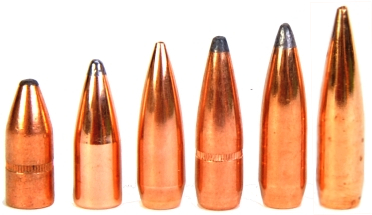
| 65,000 PSI – Experimental – For Use In Bolt Action Rifles Only | ||||||
| Bullet Type | Bullet Weight |
C.O.L. | Powder Type |
Charge | Muzzle Velocity |
Muzzle Energy |
| Remington PSP | 125 | 2.070 | Re7 | 35.5 | 2872 | 2290 |
| Remington PSP | 125 | 2.070 | Re10 | 37.5 | 2870 | 2287 |
| Hornady GR SP | 130 | 2.170 | Re7 | 35.0 | 2800 | 2264 |
| Hornady GR SP | 130 | 2.170 | Re10 | 36.8 | 2861 | 2363 |
| Sierra MK | 135 | 2.200 | Re10 | 36.5 | 2755 | 2276 |
| Sierra MK | 135 | 2.200 | RS-TAC | 41.5 | 2834 | 2408 |
| Hornady SP* | 150 | 2.220 | Re10 | 34.0 | 2525 | 2124 |
| Hornady SP | 150 | 2.220 | Re10 | 34.6 | 2572 | 2204 |
| Hornady SP | 150 | 2.220 | RS-TAC | 39.0 | 2667 | 2370 |
| Sierra SPBT | 165 | 2.260 | Re10 | 33.0 | 2479 | 2252 |
| Sierra SPBT | 165 | 2.260 | RS-TAC | 37.7 | 2560 | 2402 |
| Berger VLD 30512 | 175 | 2.275 | Re10 | 31.5 | 2312 | 2078 |
| Berger VLD 30512 | 175 | 2.275 | Benchmark | 33.8 | 2407 | 2252 |
| Most Accurate | CCI 450 Primers | Max COL 2.260″ | ||||||
Tools slightly better than pointed sticks…
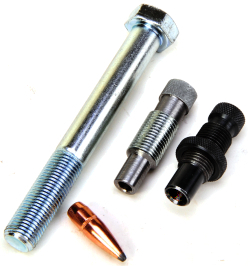
The seater plug that came with the Redding die set worked fine with bullets 150 grains and greater. Below that weight range, the bullets I selected had long tapering ogives. Consequently, they were deep into the plug before contact was made. As a result, the plug had an insufficient range of adjustment before the bullet was seated to the desired depth. I am sure this is an anomaly related to the ultra stubby 30 Remington AR cartridge and the specific bullet selection.
My tool fabricating skills are very rudimentary… some say almost chimp-like. If they work, I’m good, as long as I don’t get splinters using them and they don’t damage anything. I typically spend little time on finesse issues. I’ve found I can make custom bullet plugs from thirty cent 1/2″x20 hex head bolts, so I no longer find myself abandoning a project while I am waiting for UPS to deliver a replacement part from an outside source.
The plug made in our shop would have been better if it had more length in the thread so the seater plug would support a lock ring. The nose could have been turned a larger diameter for enhanced internal die support. More attention could have been paid the calculation that related to knurling and stock diameter. On the plus side, the piece worked, it was cheap to make… and it worked. Next time it will be better… maybe.
And then some other stuff…

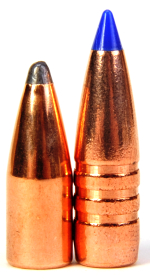 Solid copper alloy bullets were tried, however, their low density made for longish bullets that robbed critical capacity. As an example, these are 130 grain bullets, pictured right, however the blue tipped Barnes bullet is solid copper alloy. Lead core bullets weighing 175 grains are viable for use with the small .30- Remington AR case. In fact, a gun with 21″ barrel puts .30 Remington AR’s performance is very close to the .308 Winchester, with comparable bullet weights and barrel length.
Solid copper alloy bullets were tried, however, their low density made for longish bullets that robbed critical capacity. As an example, these are 130 grain bullets, pictured right, however the blue tipped Barnes bullet is solid copper alloy. Lead core bullets weighing 175 grains are viable for use with the small .30- Remington AR case. In fact, a gun with 21″ barrel puts .30 Remington AR’s performance is very close to the .308 Winchester, with comparable bullet weights and barrel length.Powder selection was.. sensitive. Re7 and Re10 worked great. A batch of 20 rounds of Re10 shot over the chronograph did not deviate in velocity more than 18 fps. Slower ball powder, BL-C2 as an example, held potential, but the loads were so dense they couldn’t be compressed to seat a heavier bullet. Ram Shot TAC provided a good balance of speed and volume. The charges were case filling, but not overly compressed except as noted and the powder performance was consistently. I guess the best all around powder for this application is Reloder 10x although IMR4227 would have probably been more optimal or perhaps Alliant Powder Pro 2000?
Field accuracy
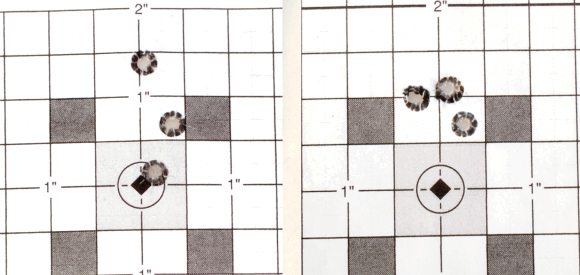
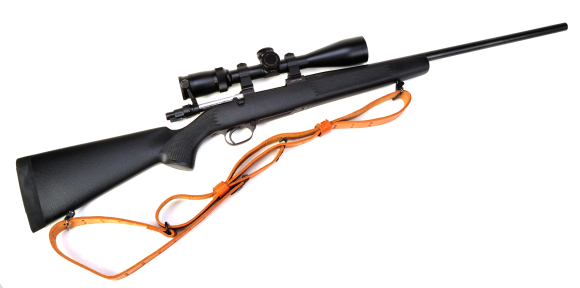

Email Notification